Ilupõõsad polnud minu jaoks esialgu kohe kindlasti mitte esimeste hulgas, keda oma aeda valida. Tundusid olevat suht palju tööd vajavad tegelased. Vajavad kärpimist ja lisaks suurte puude lehtedele hakka veel nende järelt ka koristama. Mille jaoks? Pole vaja! Pealegi oli meil maja kõrval juba olemas aiaga kaasa saadud katuseni küündiv vägev ja hästilõhnav ebajasmiin. Ja kusagil taga aianurgas ka kevadel uhkelt õitsev kasulike viljadega ebaküdoonia. Viimast üritasime sealt naatide käest päästa ja väljapaistvamasse kasvukohta istutada, mis osutus aga lootusetuks ettevõtmiseks. Juured olid lihtsalt nii sügaval, et lõpuks loobusime. Nii võitleb ta seal naatidega tänaseni. Ebajasmiini alt sain aga aia äärde hekiks terve hulga võsusid, nii et tänaseks on meil kevaditi nende õitsemise ajal ümber maja võrratu lõhn. Tegelikult ongi meil seal terve lõhnahekk: alustab sirel, kelle tassisime oma aeda kusagilt mahajäetud talukohast ja kel läks aastaid aega, et lopsakas välja nägema hakata. Talle järgneb näärelehine roos ja siis lõpuks ebajasmiin.
For me, ornamental shrubs were definitely not among the first choose for my garden. The characters seemed to need quite a lot of work. They need pruning, and in addition to the leaves of the big trees, also I start cleaning up after them. For what? No need! Besides, we already had a powerful and fragrant mock orange next to the house, which we got with the garden, it reaching up to the roof. And somewhere in the corner of the back garden, a Flowering quince with useful fruits also blooms proudly in the spring. We tried to save the latter from there and plant it in a more prominent place, which turned out to be a hopeless venture. The roots were just so deep that we finally gave up. That’s how he fights the ground elders there to this day. However, I got a whole bunch of shoots from under the mock orange as a hedge along the fence, so today we have an amazing smell around the house when they bloom in the spring. In fact, we have a whole scented hedge there: starting with common lilac, which we brought into our garden from an abandoned farm somewhere and which took years to start looking lush. It is followed by Scotch Rose and finally by mock orange.
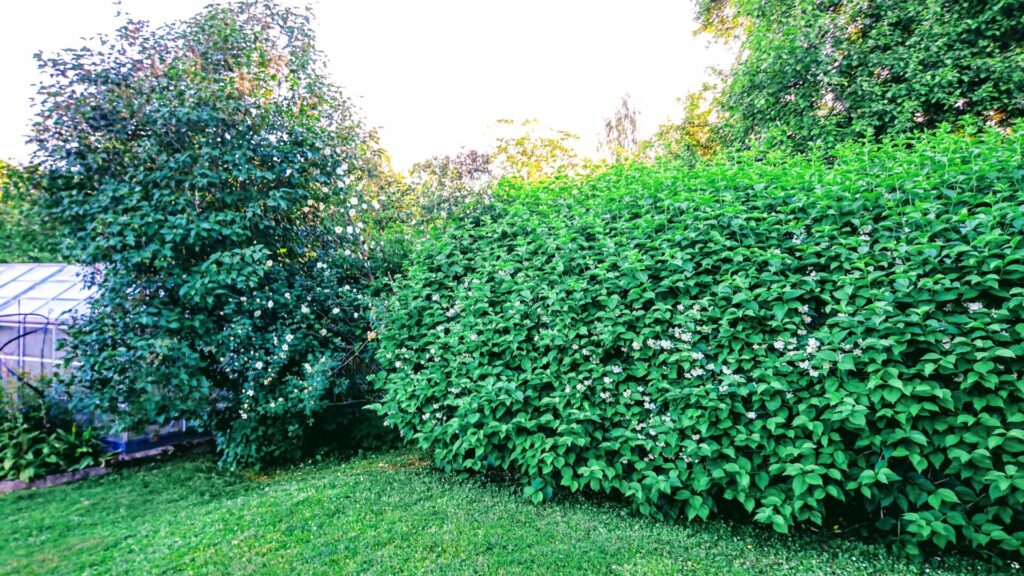
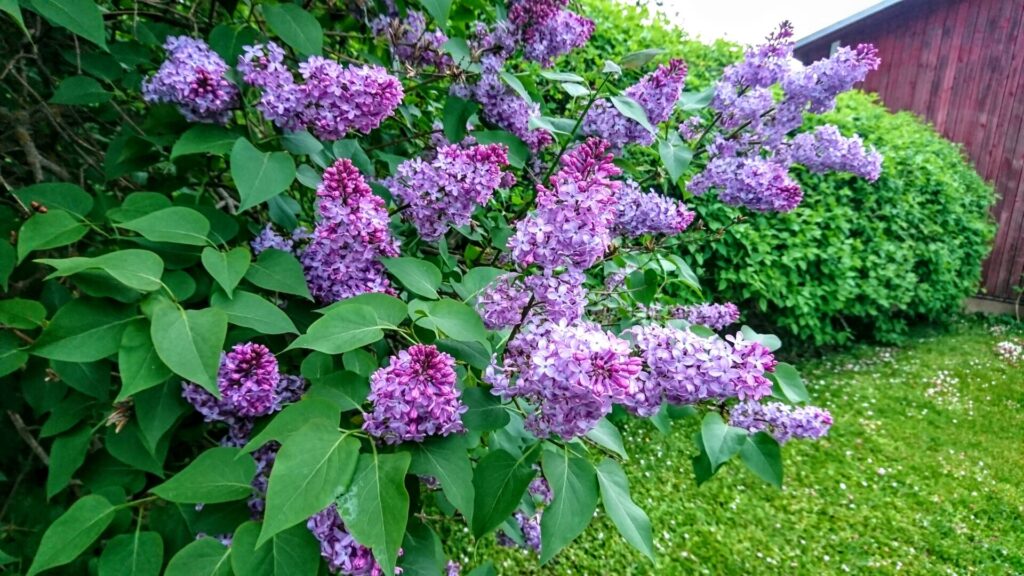
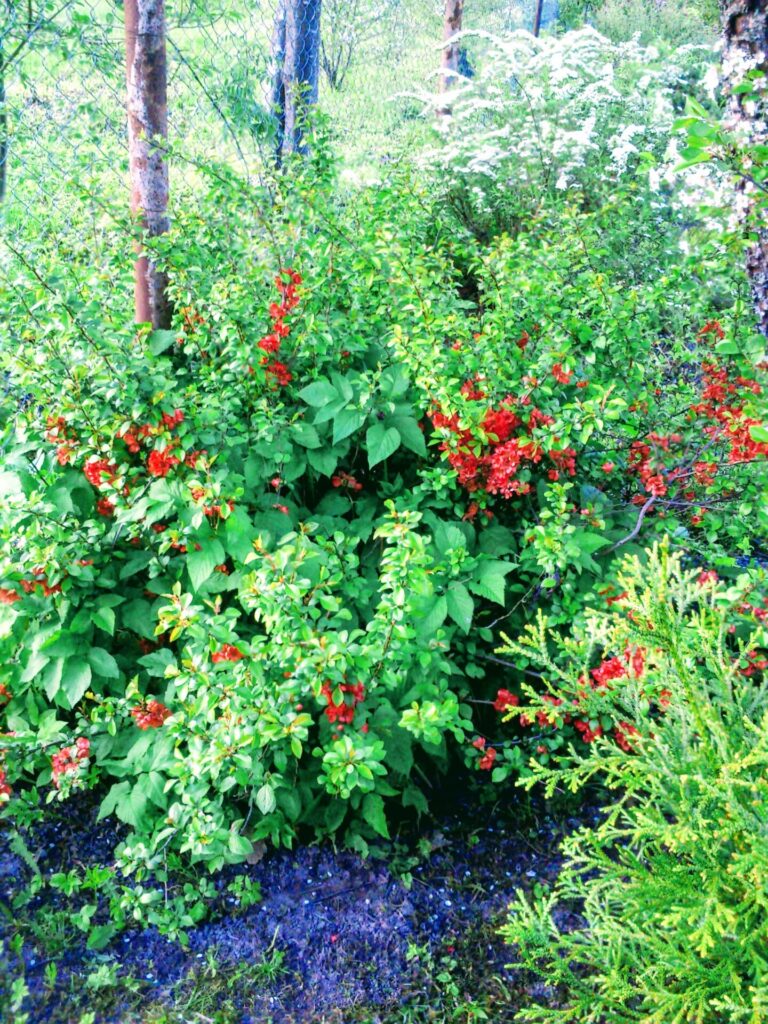
Ebaküdoonia tagant paistab viimase pildi peal ka tuhkur enelas Grefsheim, kelle sain sõbranna põõsa juurevõsuna. Tema on üks neist, kes mu ilupõõsa-vaimustust kärbib, sest pidevalt jään ma tema äraõitsenud õite eemaldamisega hiljaks või ununeb see hoopis. Nii avastangi üle paari aasta, et ta on noorendamata ja lihtsalt kole.
In the last picture, the Garland spirea Grefsheim, which I got as a root shoot of a friend’s bush, can be seen from behind the Flowering quince. He is one of those who curtails my passion for the ornamental shrubs, because I am constantly late to remove the flowers that have bloomed, or I forget to do so. So I discovered over a couple of years that he has not been rejuvenated and is simply ugly.
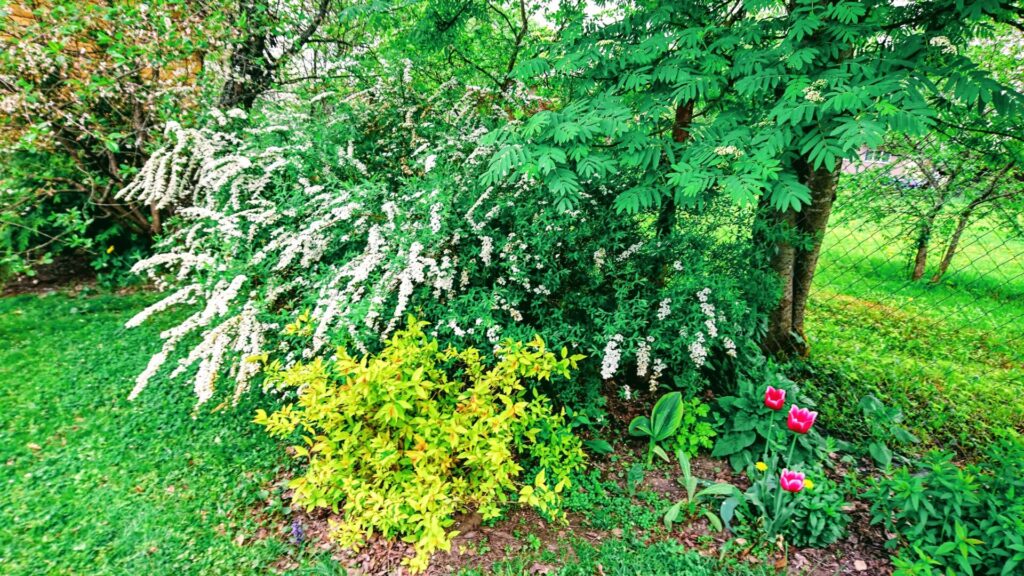
Aias olid enne meid veel läiklehine mahoonia ja suur harilik lodjapuu Roseum ehk Lumepall. Viimase väljakaevamiseks ja praegusesse kasvukohta transportimiseks läks lausa traktorit vaja, mis selle töö kopaga ära tegi.
In the garden before us there were still a Oregon Grape and a large European Cranberrybush Roseum or Snowball. To dig out the latter and transport it to the current growing site, a tractor was needed, which did the job with a bucket.
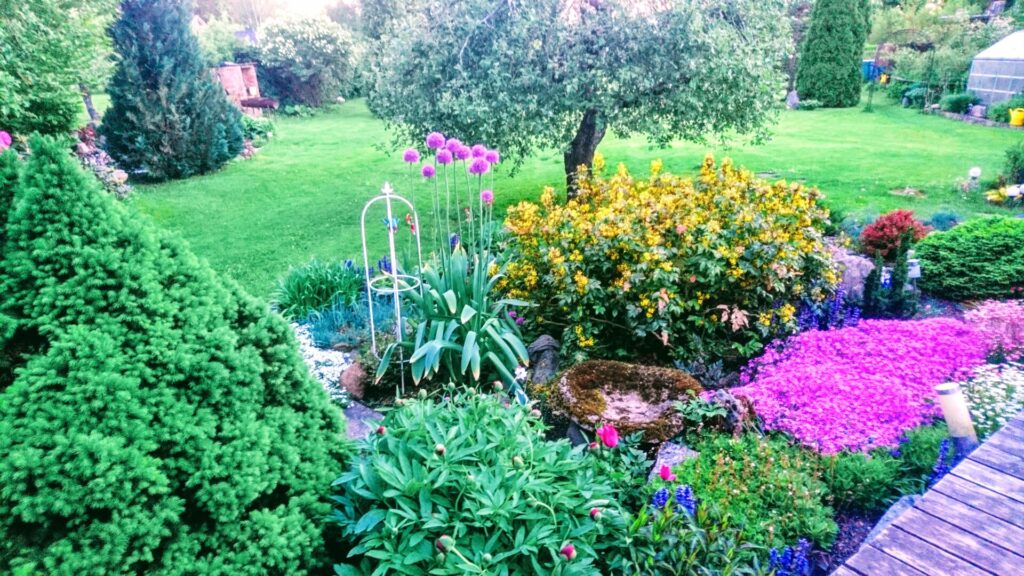
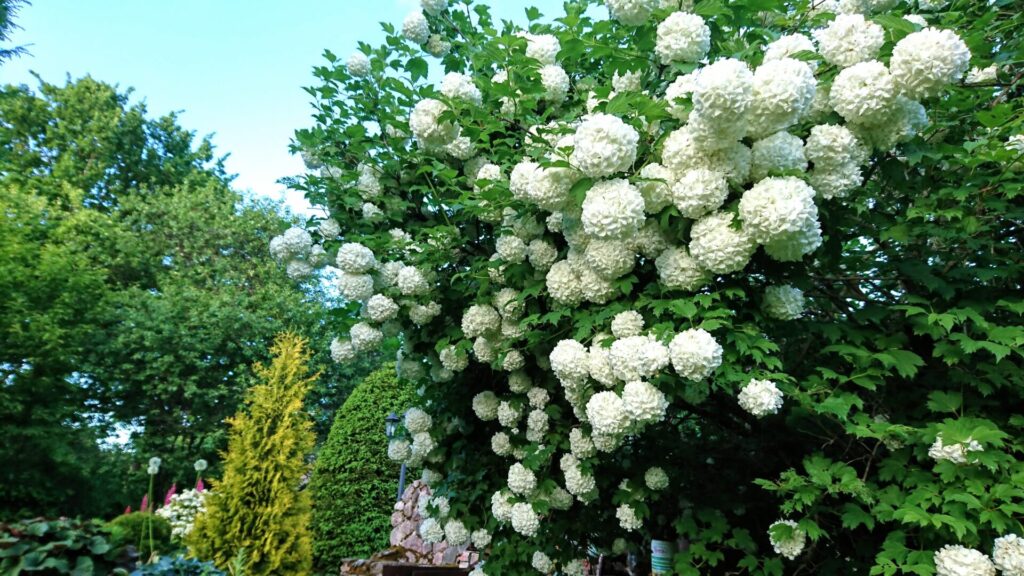
Ilupõõsaste alla kuuluvad ka kõikvõimalikud hekitaimed. Ühe esimese tööna oma aias istutasime krundi piiridele tuhkpuuheki. Sellega kaasneb ka igasuvine hekilõikus, mis on aga ilmselge paratamatus.
Ornamental shrubs also include all kinds of hedge plants. As one of the first jobs in our garden, we planted an Scandinavian cotoneaster hedge on the borders of the plot. This is also accompanied by hedge cutting every summer, which is, however, an obvious inevitability.
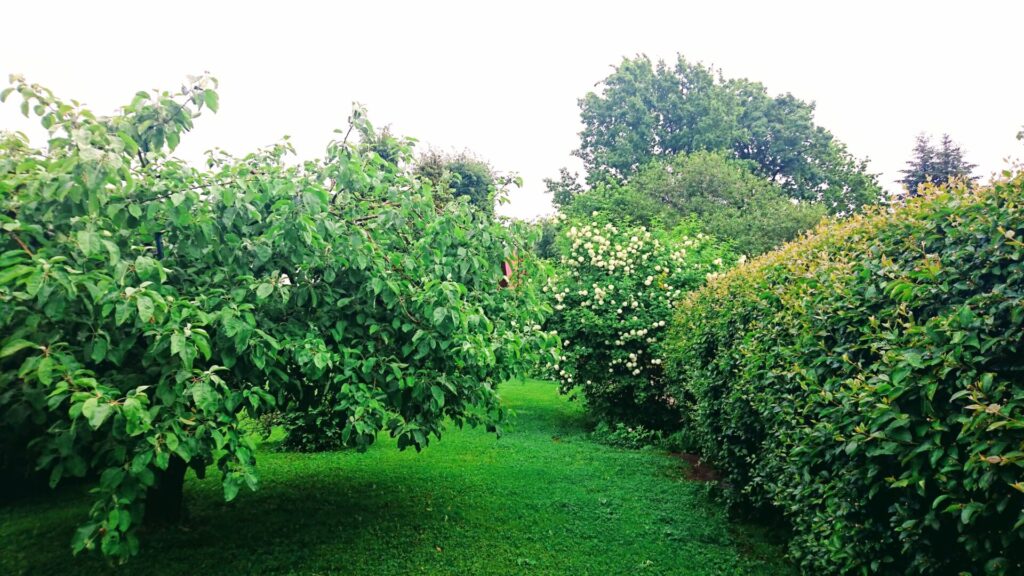
Mingil hetkel aga hakkasid igasugused värvilised ilupõõsad mulle puukoolides ja müügiplatsidel silma jääma. 2006. aastal sai ostetud jaapani enelas Goldflame.
At some point, however, all kinds of colorful ornamental shrubs started to catch my eye in nurseries and sales pitches. In 2006, we bought the Japanese spiraea Goldflame.
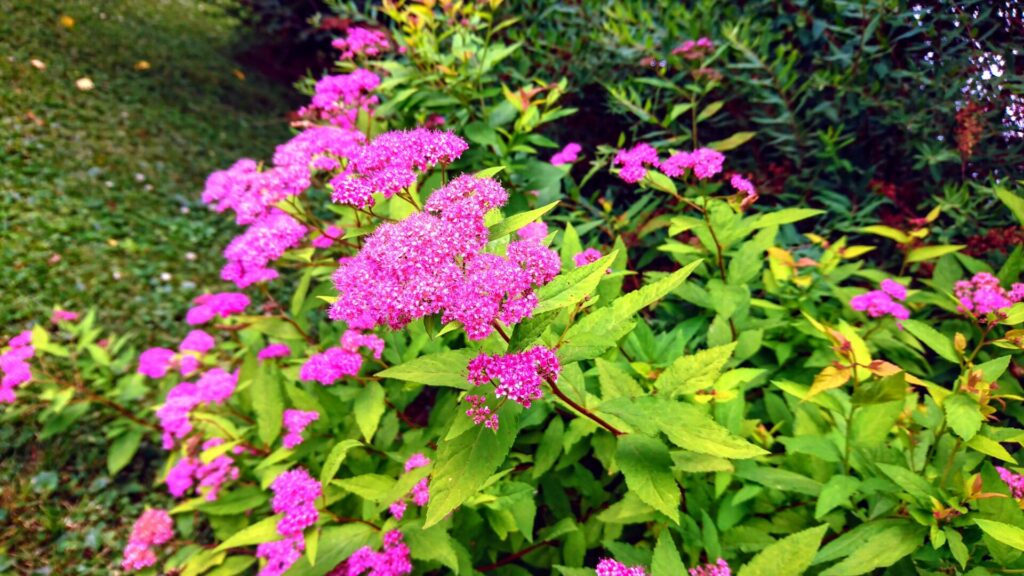
2009. aastal lisandusid siberi kontpuud Argenteo-marginata ja 2010 Elegantissima. Neile peab küll aeg-ajalt noorenduslõikust tegema, aga selle töö me võtame ette vastavalt vajadusele üle paari aasta.
In 2009, the Siberian dogwood Argenteo-marginata and in 2010 Elegantissima was added. They do have to be rejuvenated from time to time, but we undertake this work over a couple of years as needed.
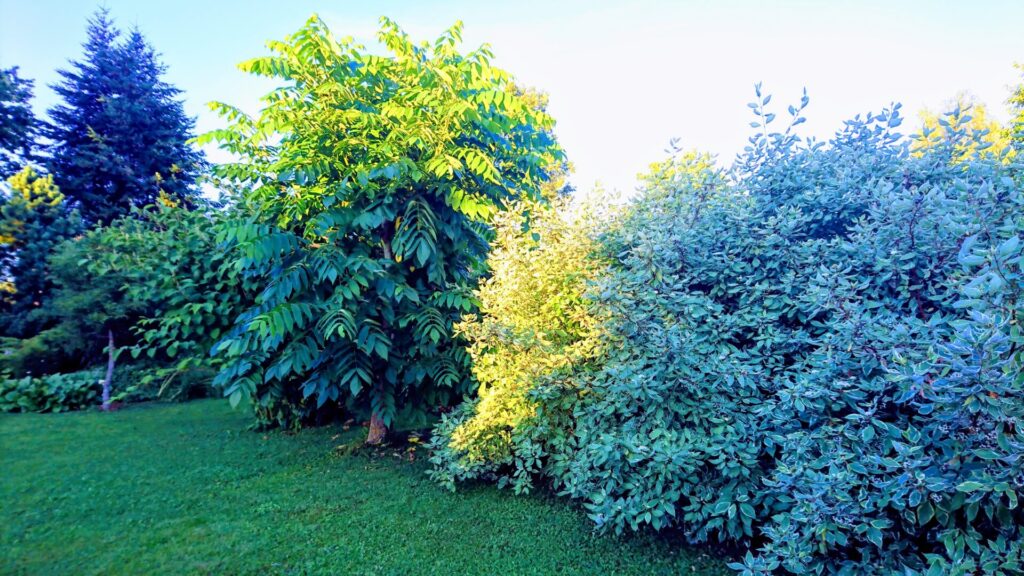
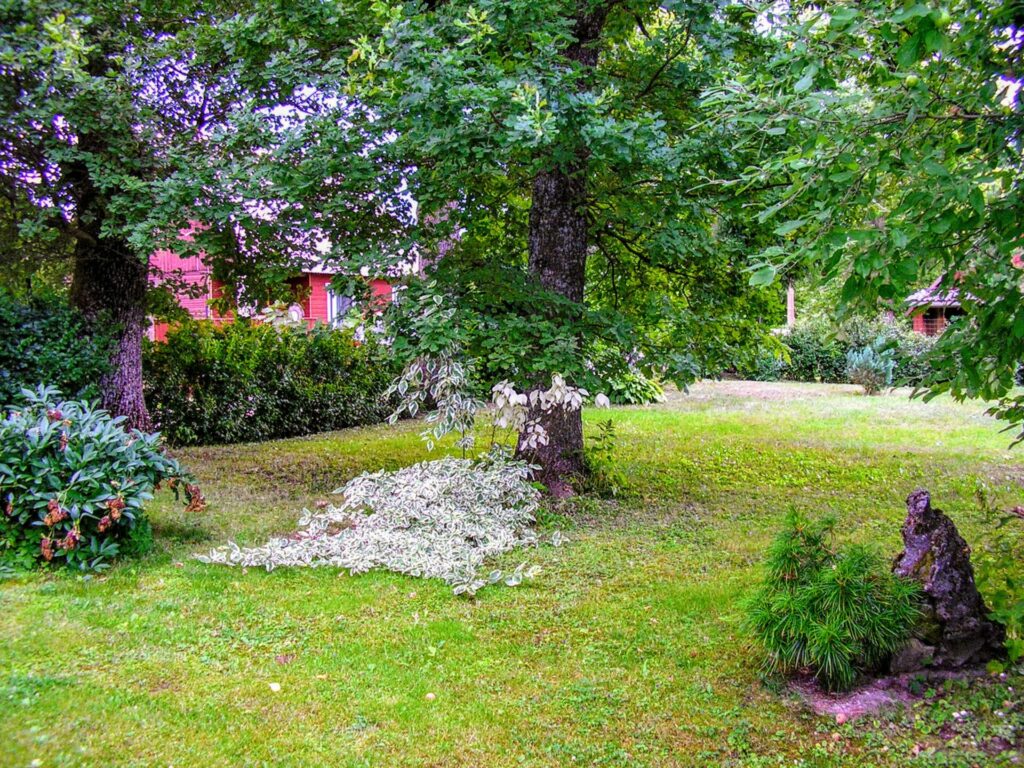
Vanalt aiamaalt tõime uude aeda kaasa ka kunagi kilekotiga mere äärest kaasa võetud juurejupist kasvanud suure marjaga kurdlehise kibuvitsa. Meil on ta vabas looduses juba tunnistatud invasiivseks võõrliigiks, aga koduaias on teda täitsa võimalik edukalt kontrolli all hoida. Püsivad tuhkpuuheki ja Lumepalliga kenasti kõrvuti ja ei sega teineteist. Vaeva tema piiramisega olen pidanud ikka väga vähe nägema.
From the old garden plot, we also brought to the new garden a rugosa Rose with a large berry that grew from a piece of root, we had taken from the seaside in a plastic bag. In our country, it is already fixed as an invasive alien species in the wild, but it is quite possible to successfully control it in the home garden. They stay nicely next to the Scandinavian cotoneaster and Snowball and do not interfere with each other. I have had to see very little trouble with his limiting.
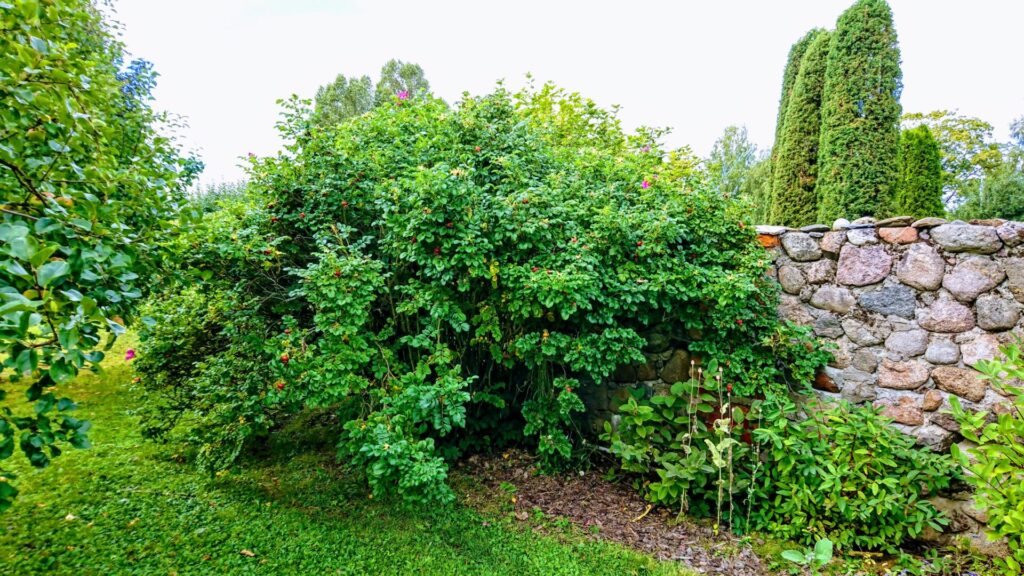
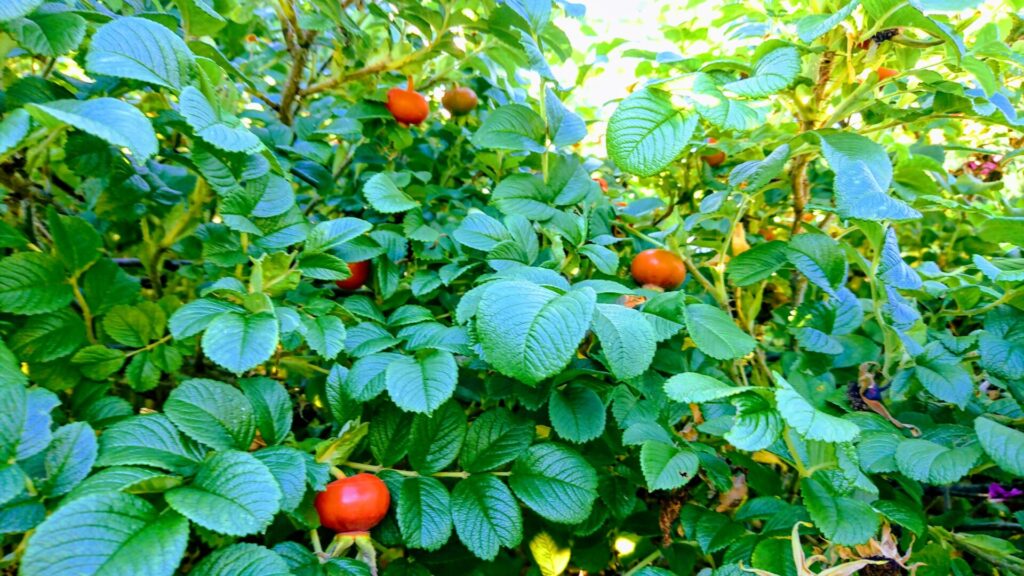
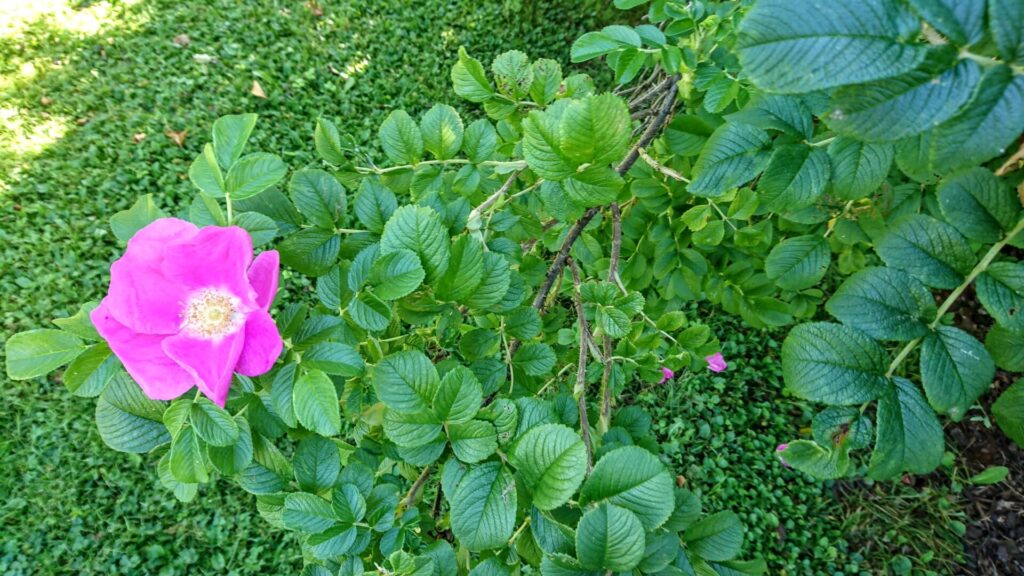
Krundi piirdele istutasin 2010. aastal kahte sorti lodjapuulehist põisenelat: kollane Luteus ja tumelilla Red Baron. Noorenduslõikust aeg-ajalt vajavad, aga mitte väga tihti. Seda kena ilupõõsast istutasin juurde 2021 sordi All Black ja 2022 Diable d’Or.
In 2010, I planted two varieties of ninebark on the border of the plot: yellow Luteus and dark purple Red Baron. Rejuvenation cutting is needed from time to time, but not very often. I planted 2021 variety All Black and 2022 Diable d’Or from this beautiful shrub.
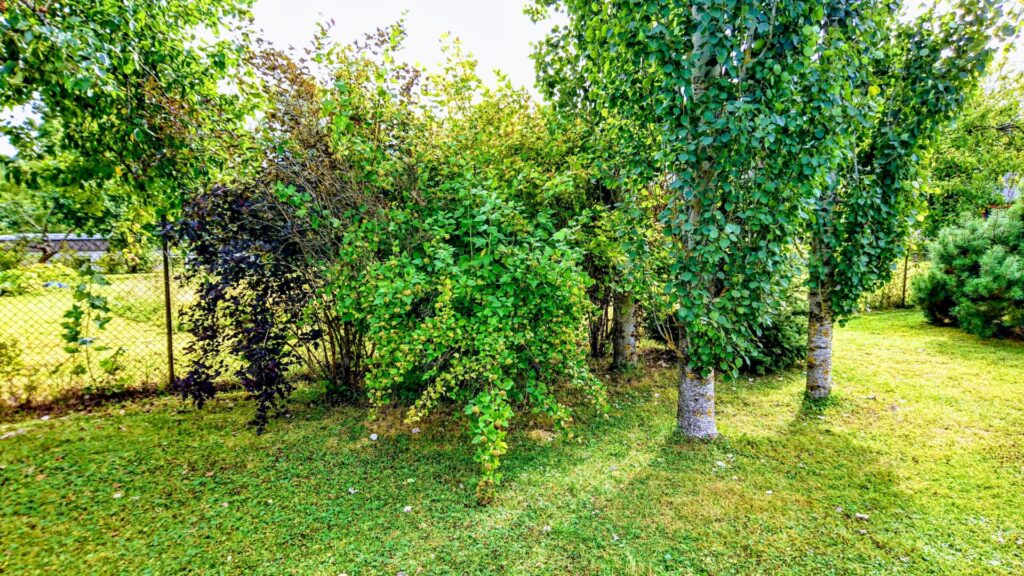
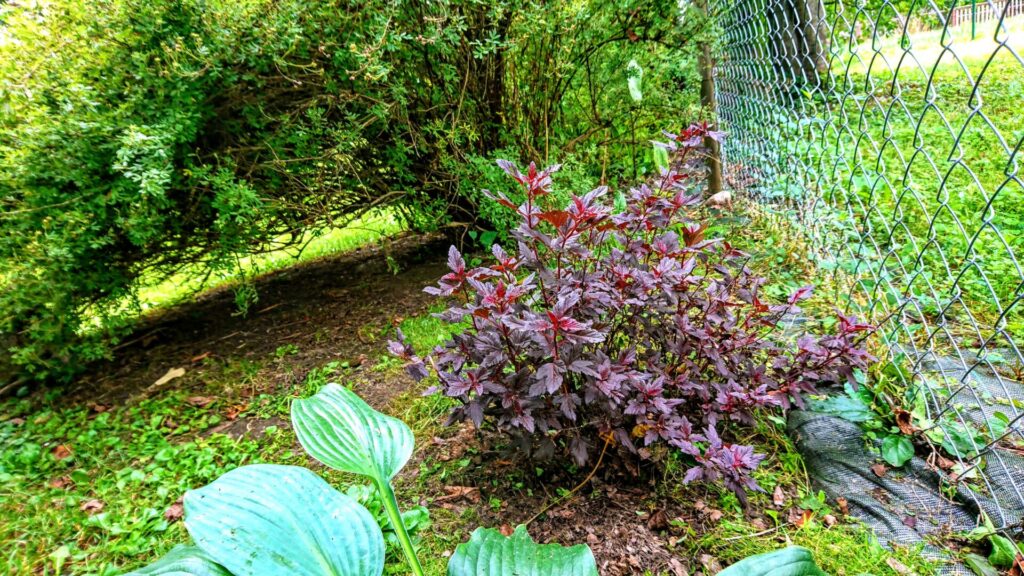
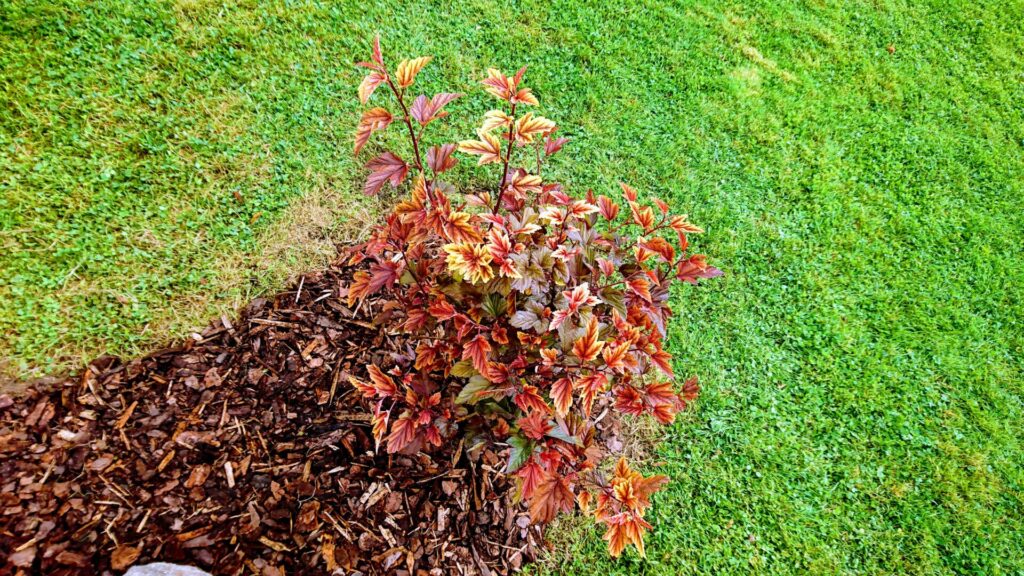
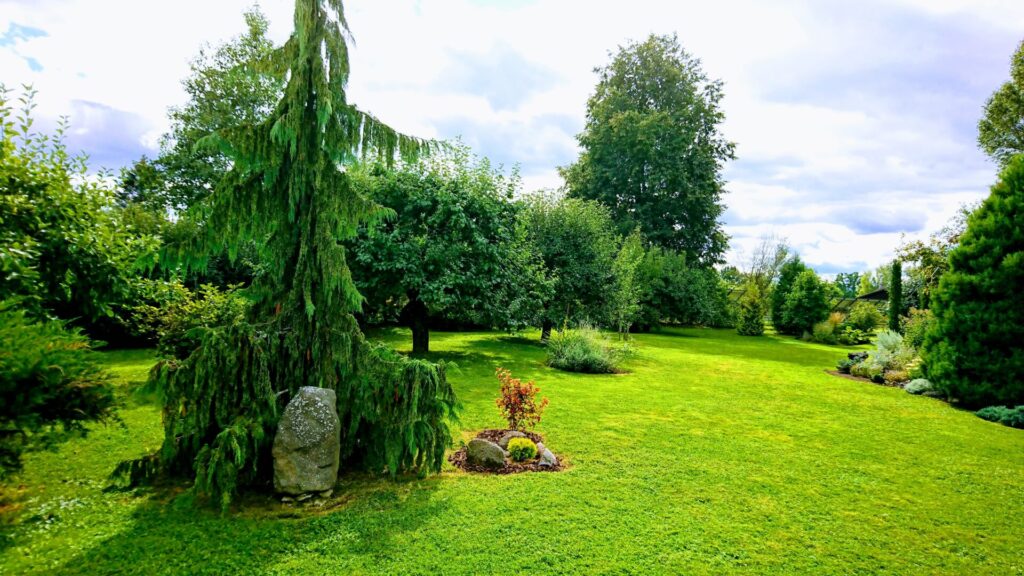
Jaapani enelas Macrophylla on istutatud 2010. aastal okkaliste sekka ja noorendab ennast seal olelusvõitluse käigus ise. Aeg-ajalt lõikan ära kuivanud oksad, kui need juba väga silma riivama hakkavad. Tegelikult soovitatakse teda iga-aastaselt värskendada, et saada ilusaid värvilisi noori oksi, aga nagu öeldud: meil noorendab ta end ise.
The Japanese spirea Macrophylla was planted in 2010 among the conifers and rejuvenates itself there during the struggle for existence. From time to time, I cut off the dried branches, when they start to disturb the eye. In fact, it is recommended to refresh it every year to get beautiful, colorful young branches, but as said: in us, it rejuvenates itself.
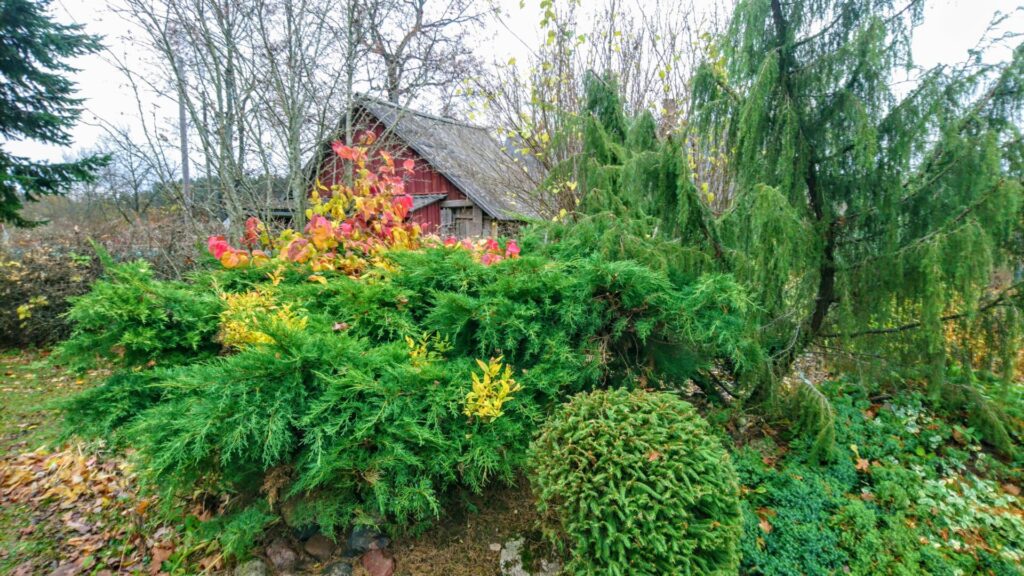
Aastal 2015 sain sõbranna käest põõsajupikese: nipponi enelas Gerlve`s Rainbow. Tal oli mingil kombel õnnestunud parasjagu just müügiplatsilt ostetud istik pooleks harutada ja nii see meile jõudiski. Ilupõõsastest on see mu suurim lemmik: väga ilus nii õitega kui ilma ja kääre nõuab haruharva, et mõni kuivanud oksake ära lõigata. Tõeline iludus!
In 2015, I received a piece of the shrub from a friend: spiraes Nipponica Gerlve’s Rainbow. He somehow managed to cut a shrub he had just bought in the market in half and that’s how it came to us. It is my biggest favorite among ornamental shrubs: very beautiful both with and without flowers, and rarely required the scissors to cut off a dried branch. A true beauty!
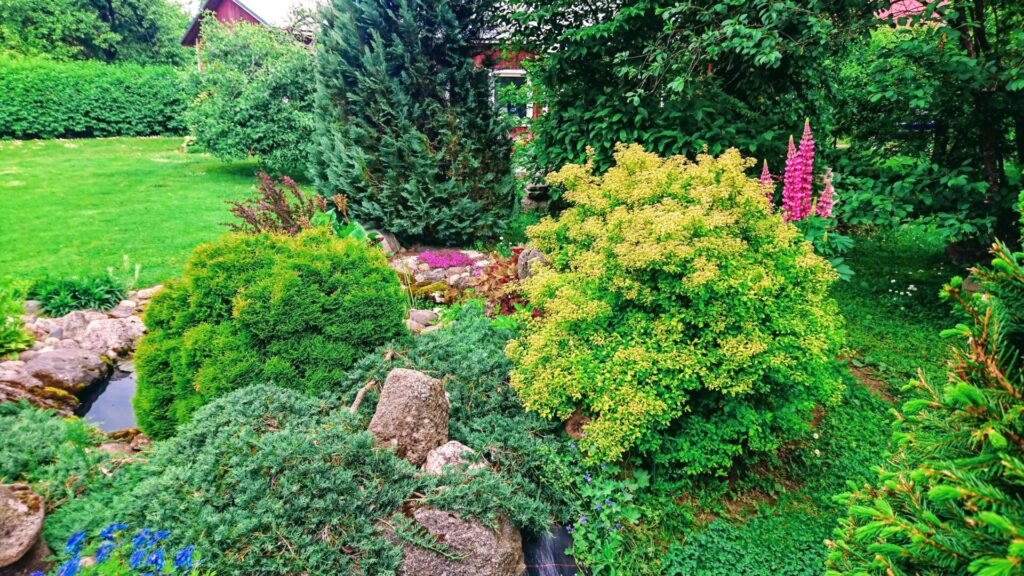
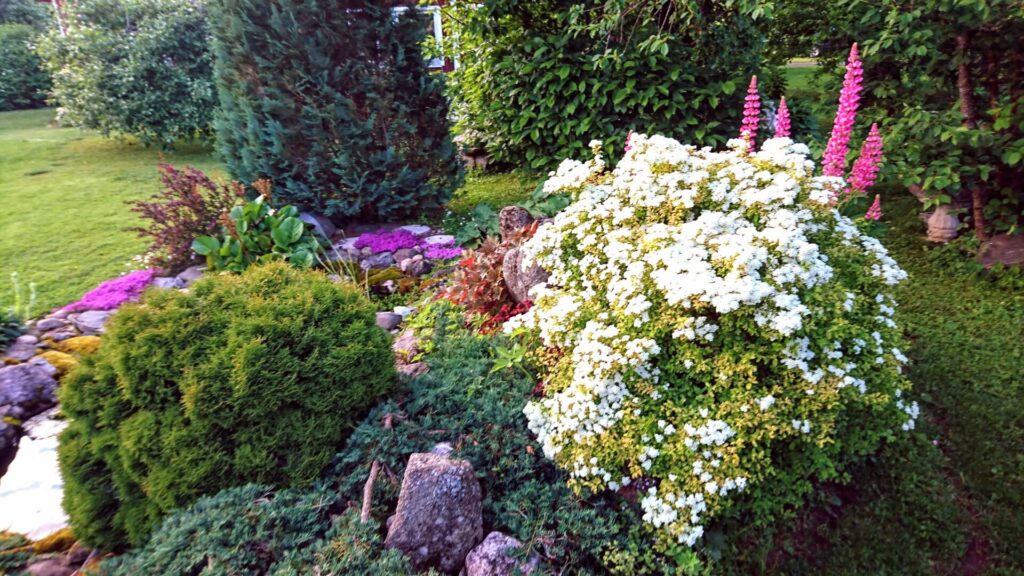
Viimasel pildil on taga bergeenia kõrval näha Thunbergi kukerpuud Harlequin, kes maandus sinna 2018. Samal aastal ostsime veel sordi Admiration ja sellest ajast saati hoian neil värvilistel tegelastel müügiplatsides silma peal. 2020 lisandus Red Chief, 2021 Orange Sunrise, Maria, Dart’s Red Lady ja Ruby Star, 2022 Red Pillar. Viimasele peab küll leidma veel päikeseküllasema kasvukoha, sest senises kohas otsustas ta suvega punase asemel roheliseks muutuda.
In the last picture, next to the bergenia, you can see Thunberg’s barberry Harlequin, which landed there in 2018. In the same year, we also bought the variety Admiration, and since then I’ve been keeping an eye on these colorful characters. 2020 added Red Chief, 2021 Orange Sunrise, Maria, Dart’s Red Lady and Ruby Star, 2022 Red Pillar. The latter needs to find a more sunny place to grow, because in the current place it decided to turn green instead of red in the summer.
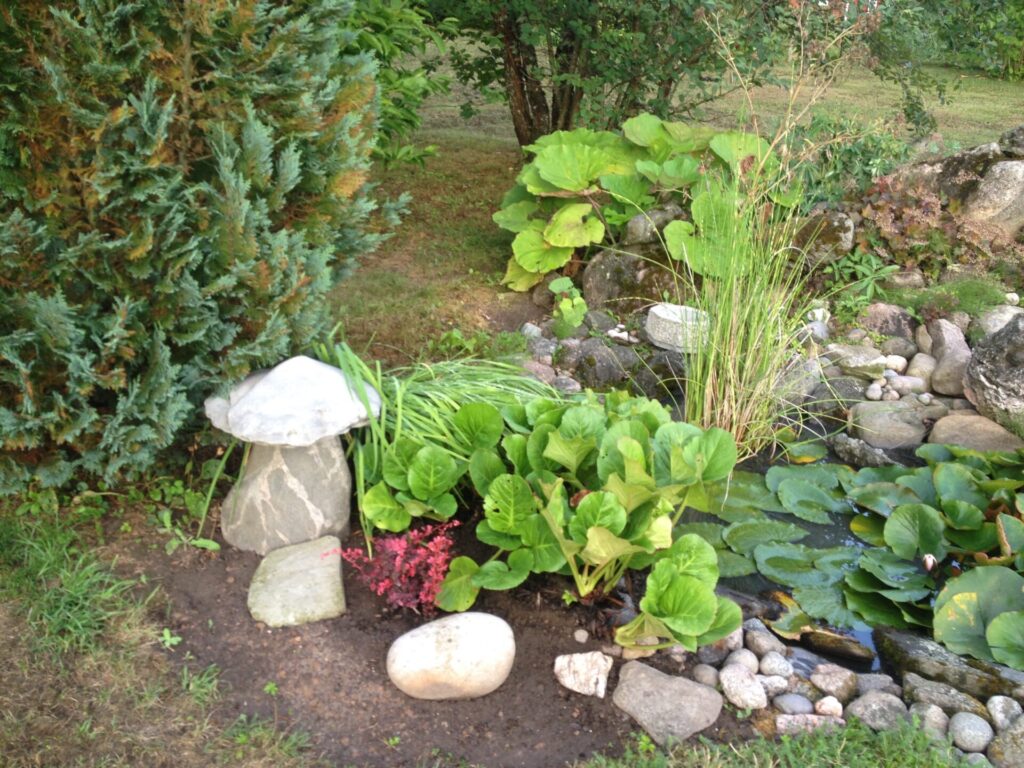

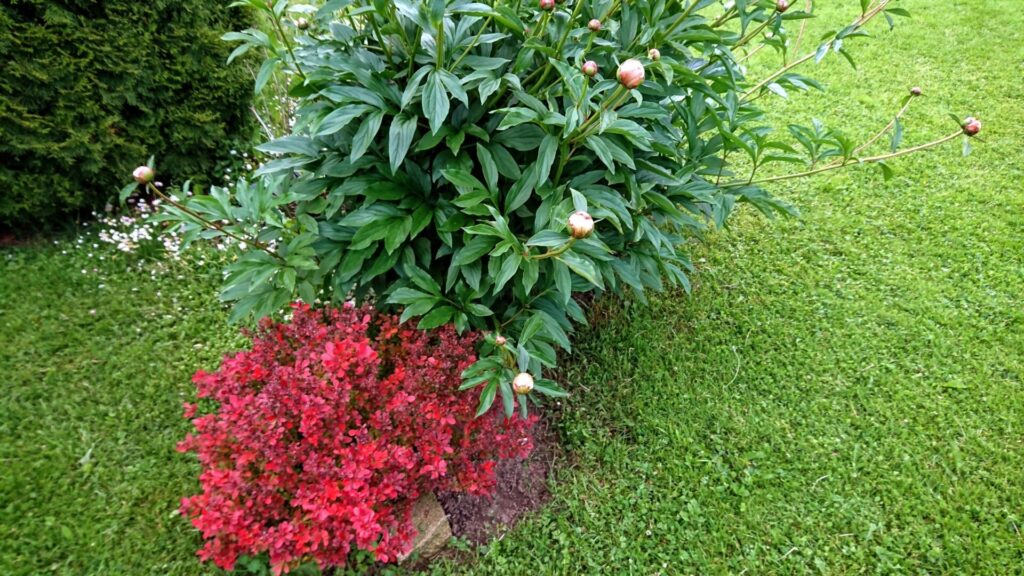
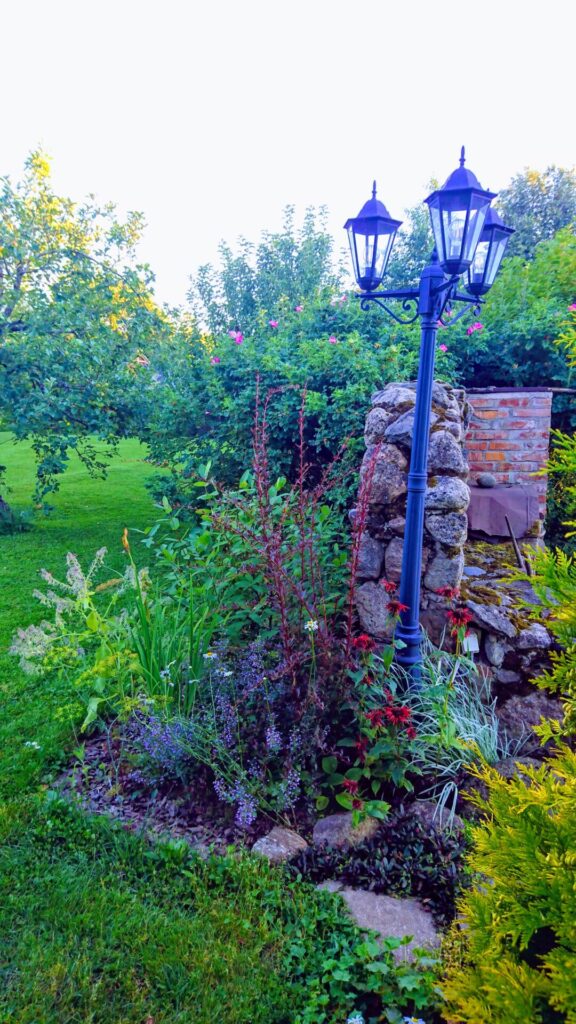
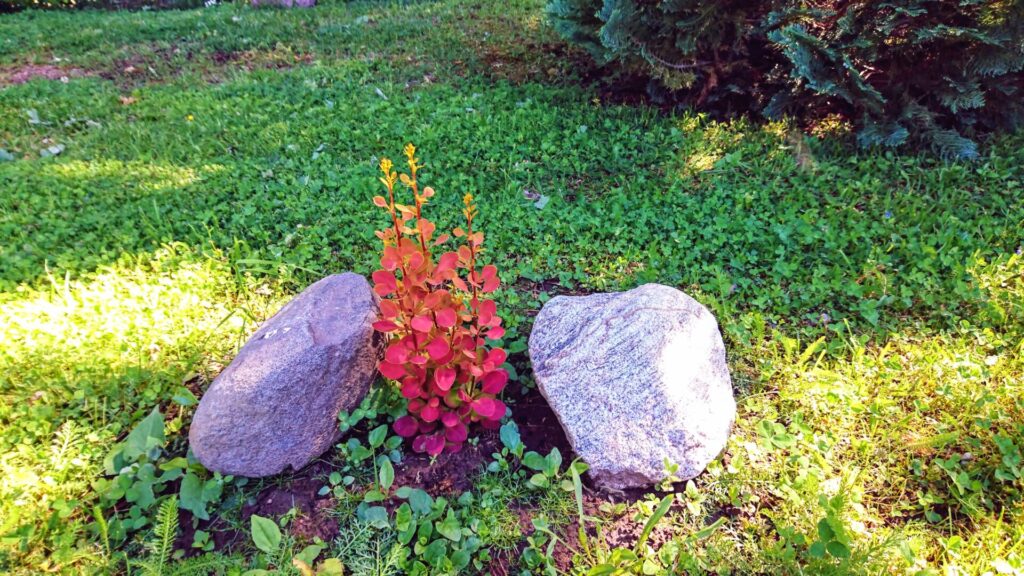
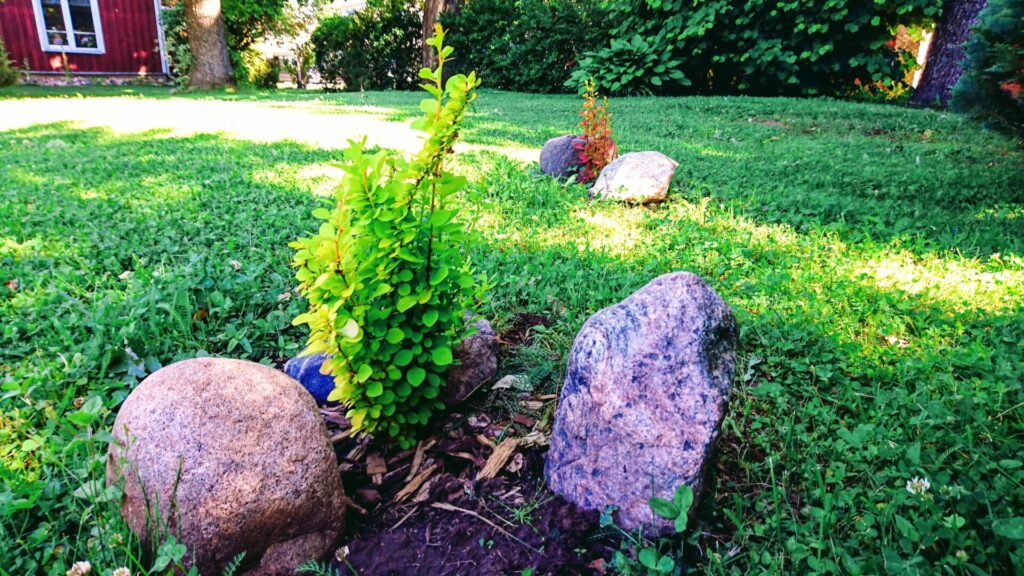
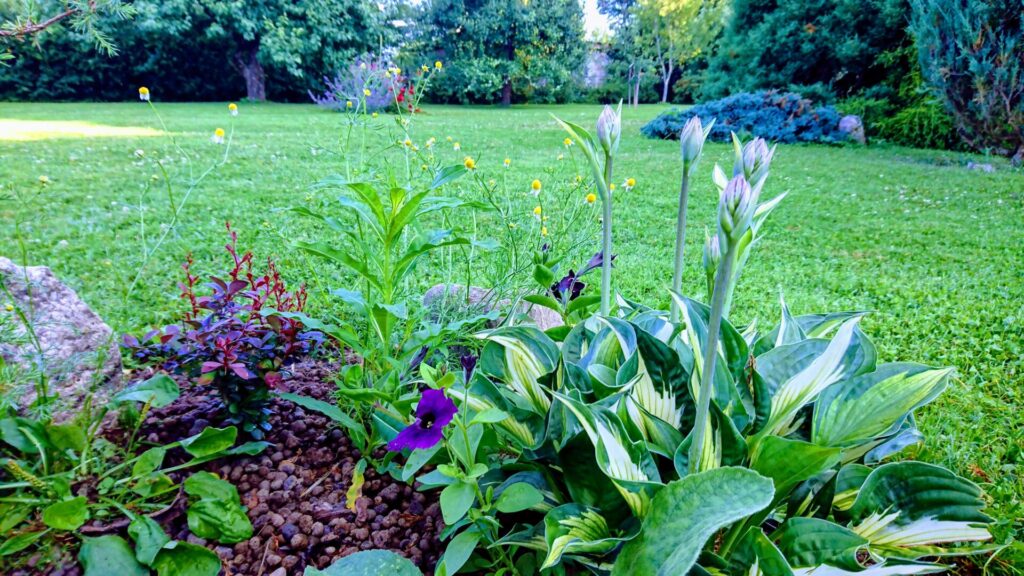
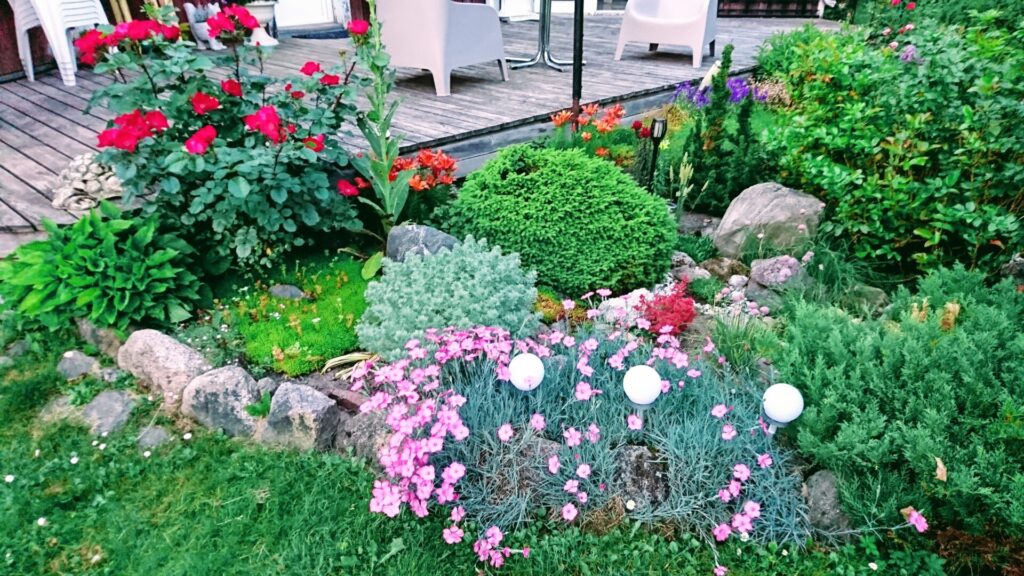
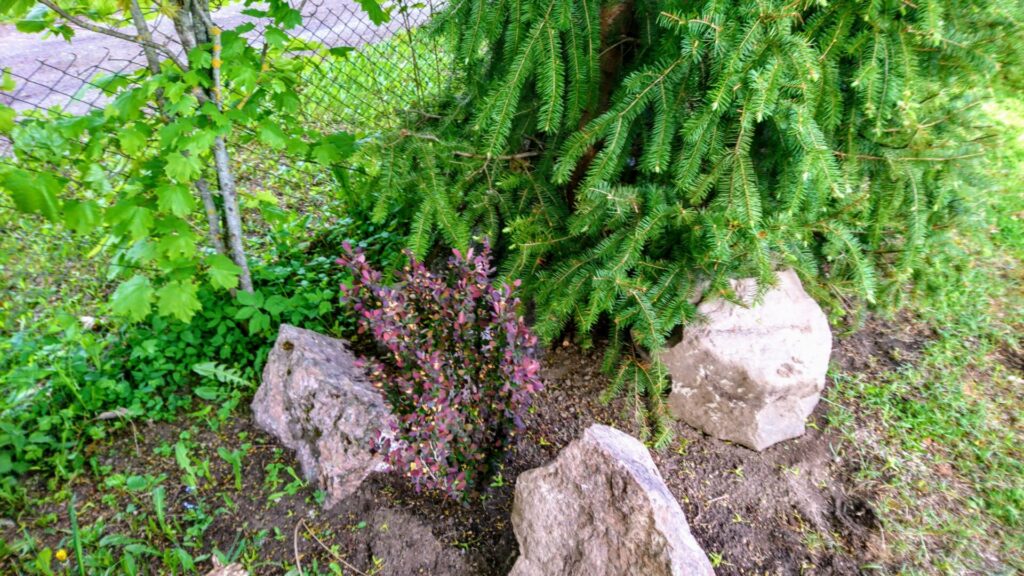
2021 sai soetatud imeilusate õitega jaapani enelas Magnum Rose.
In 2021, the japanese spirea Magnum Rose with gorgeous flowers was acquired.

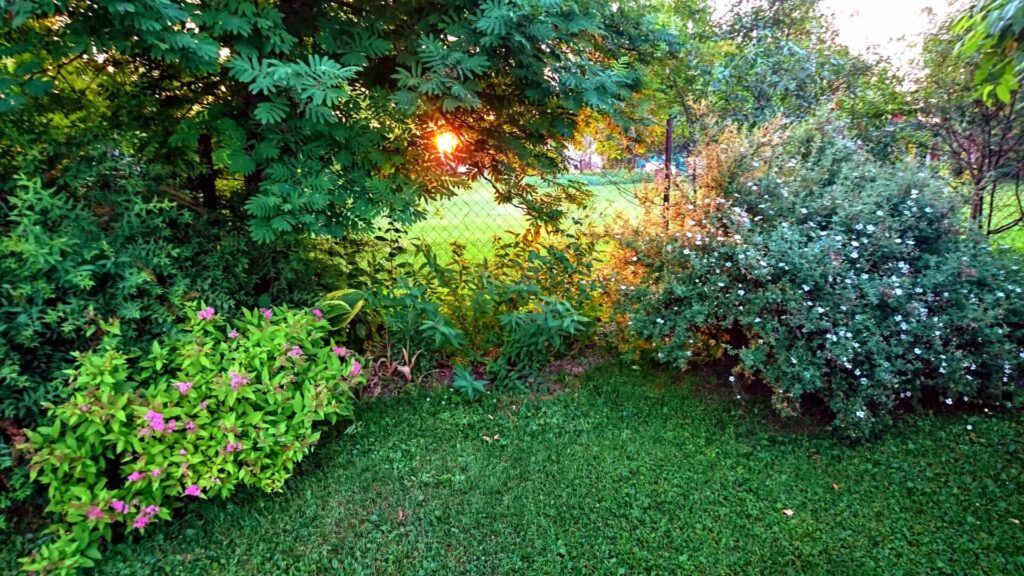
Viimasel pildil paremal on suur valgete õitega põõsasmaran, kes on saanud omatahtsi kasvada ja ilulõikust on talle vähe olnud vaja teha, sest ta peidab kevadel suht kiiresti eelmise aasta kuivanud õisikud ära. Tema eeskujul otsustasin tekitada maranatest suurema värvilaigu ja istutasin 2020. aastal põõsasmaranad Orangeade, Dart’s Golddigger (kollaste õitega), Belissima (roosa) ja Marian Red Robin (punane). Praegu seal veel mingit uhket tulemust igatahes näha pole.
In the last picture on the right, there is a large Shrubby Cinquefoil with white flowers, which has been allowed to grow as it pleases, and it has had little need for pruning, because it hides last year’s dried inflorescences quite quickly in the spring. Following his example, I decided to create a bigger patch of color from Shrubby Cinquefoil and in 2020 I planted Shrubby Cinquefoil Orangeade, Dart’s Golddigger (with yellow flowers), Belissima (pink) and Marian Red Robin (red). At the moment, however, there is no proud result yet to be seen.
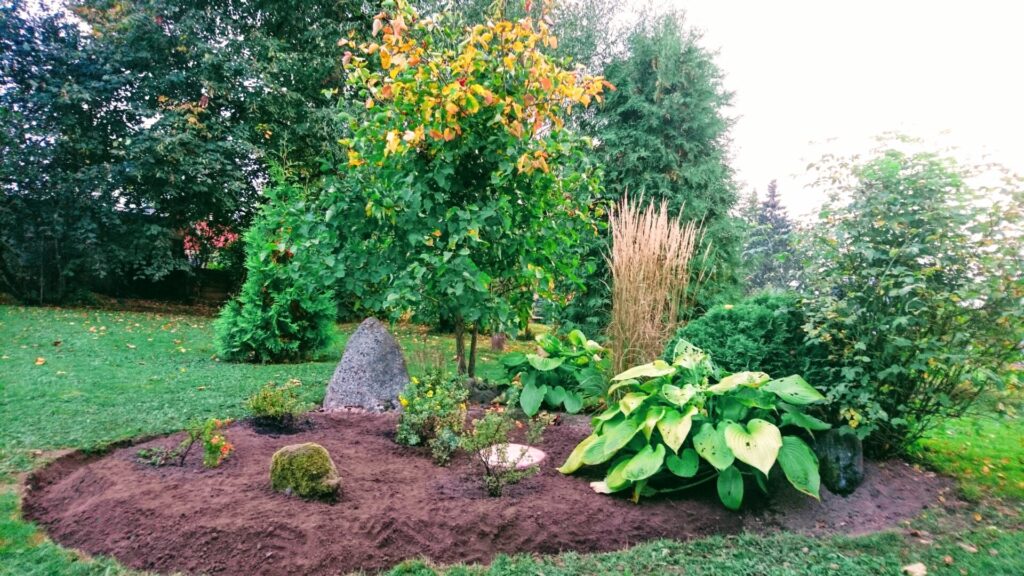
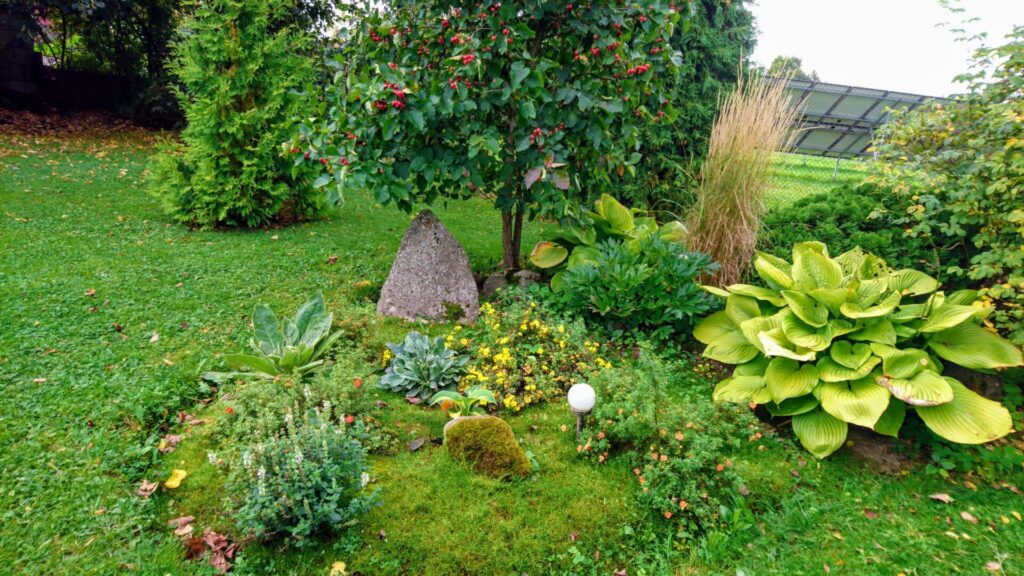
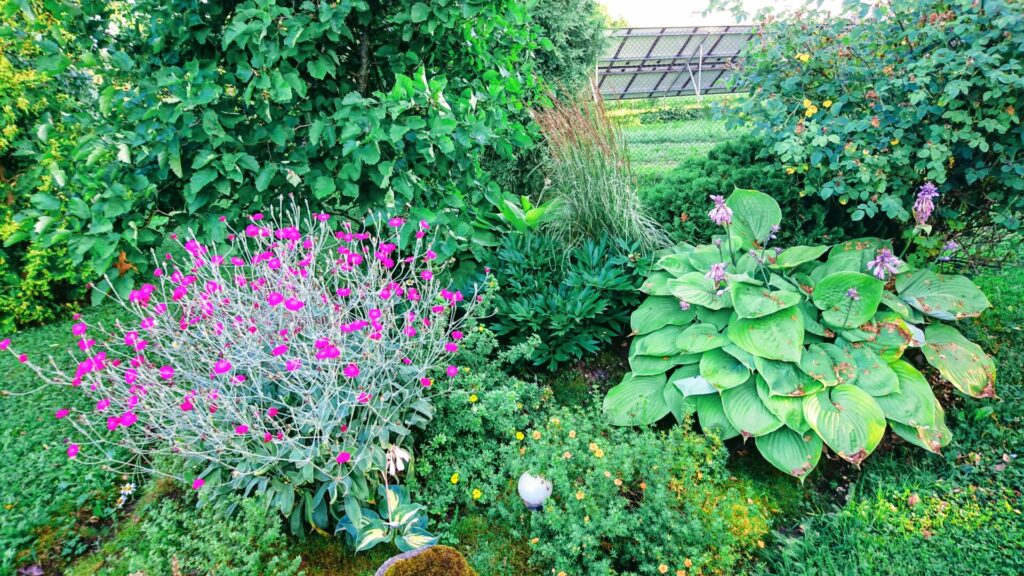
Kes meil siis veel on? 2019 istutatud must leeder Black Lace ja 2021 istutatud pukspuud. Pukspuud on täpselt samasugused nagu pärast istutamist, ilmselt tegelevad teist kuuma kuiva suve järjest ainult ellujäämisega. Mustale leedrile paistab selline kliima aga meeldivat. Viskab suvega mõned paarimeetrised oksad püsti ja siis lähevad suuremad oksad talvega välja, ilmselt ei jõua korralikult ära puituda. Aga uuel kevadel jälle uue hooga. Kurb on selle juures ainult see, et siis tuleb ka vähe õisi. Aga eks ta harjub, noor taim ka alles.
So who else do we have? 2019 planted black elder Black Lace and 2021 planted boxwoods. The boxwoods are exactly the same as they were after planting, probably them dealing with survival the second hot dry summer in a row. However, black elder seems to like this climate. In the summer, it throws up a few meter-long branches, and then the bigger branches go out in the winter, probably can’t make enough wooding for the winter. But in the new spring again with new momentum. The only sad thing about it is that there are few flowers. But he gets used to it, still a young plant.
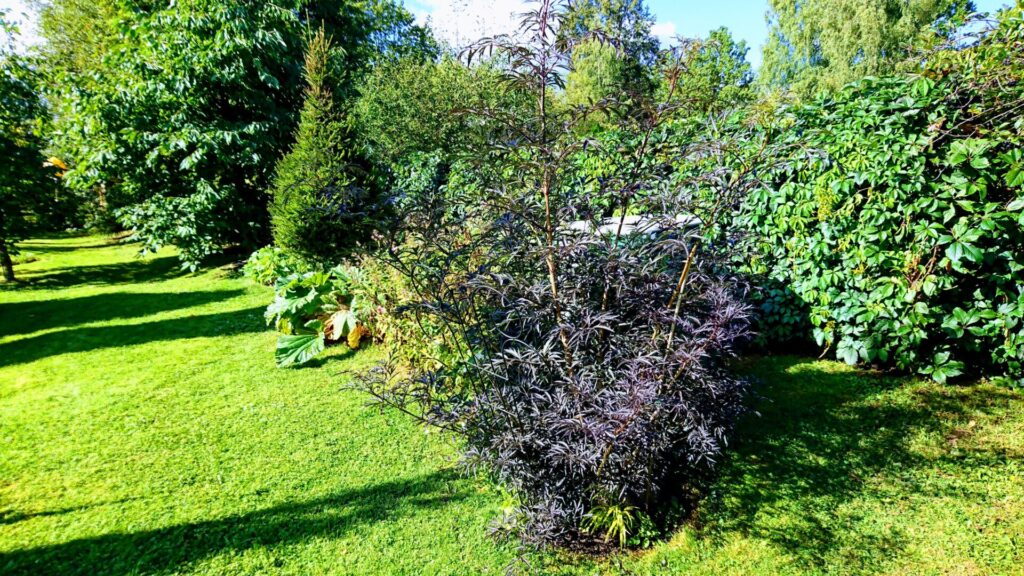
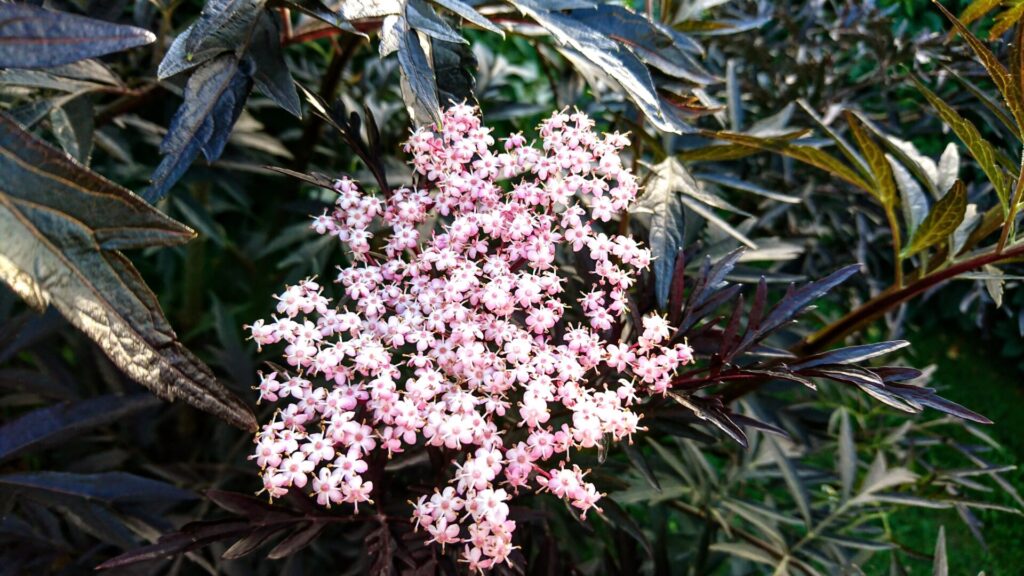
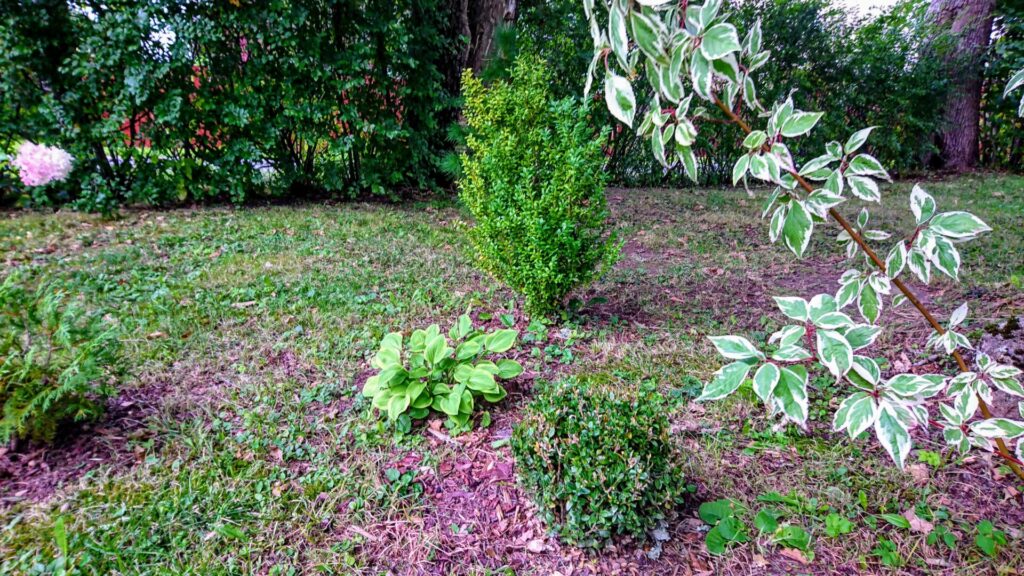
Ja muidugi veel hortensiad. Aiaga saime kaasa mitu suurt puishortensia Grandiflora põõsast, mida oleme tublisti laiali jaganud.
And of course hydrangeas. With the garden, we got several large smooth hydrangea Grandiflora shrubs, which we have divided a lot.
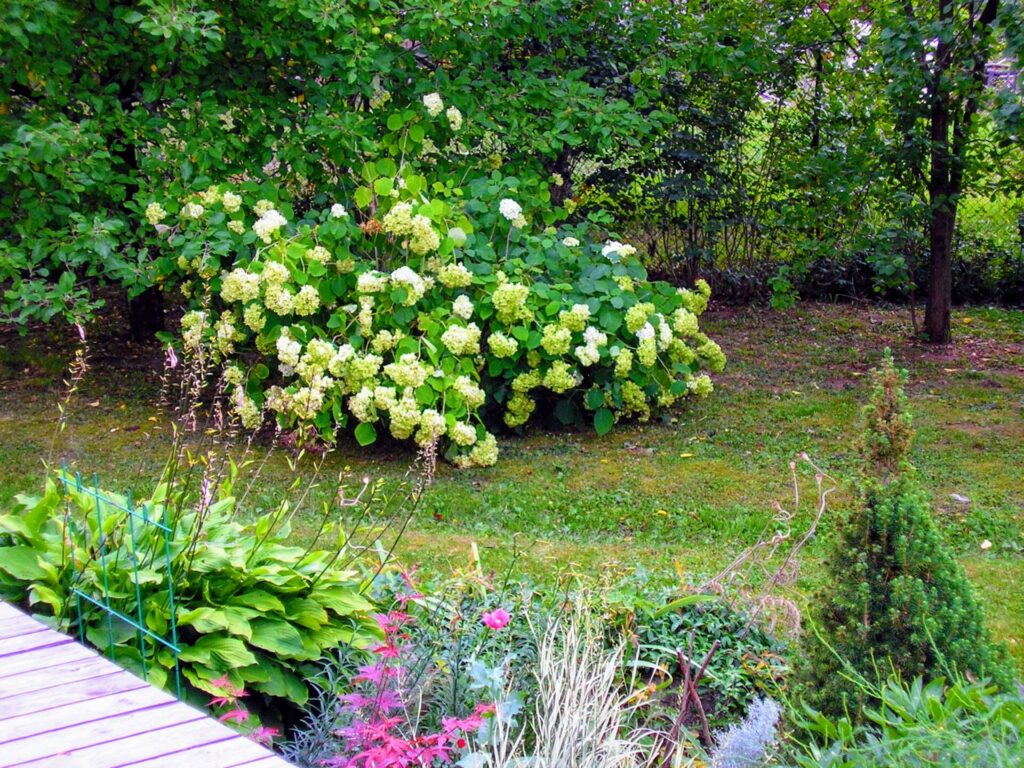
2019 soetasime aedhortensia Vanille Fraise, kellele ei meeldi vist asukoht, sest korralikku sügisvärvi ta meil ei näita.
In 2019, we bought a panicled hydrangea Vanille Fraise, which probably doesn’t like the location, because it doesn’t show proper autumn color.
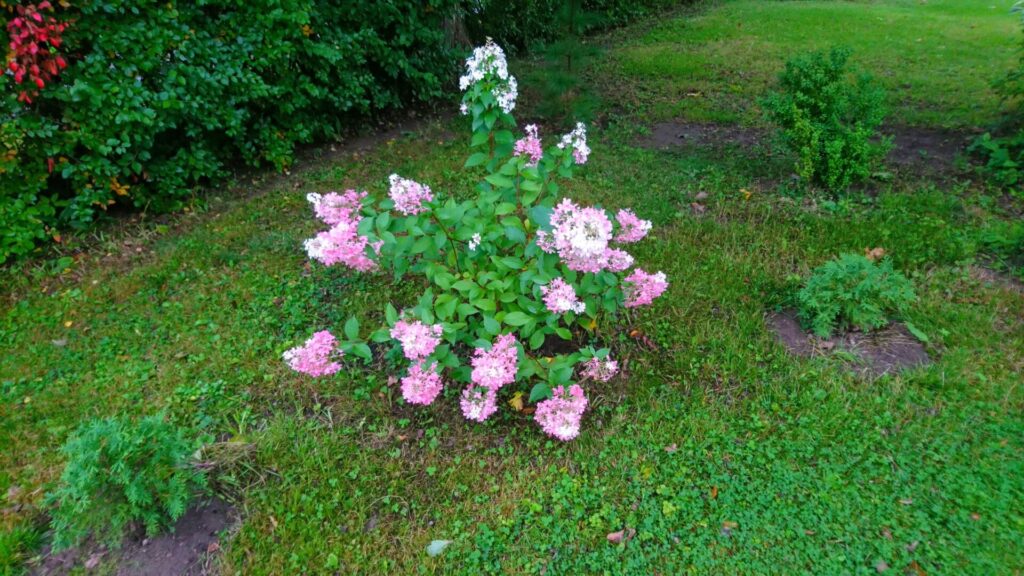
2021 lisandusid puishortensia ‘Incrediball’ ja suurelehine hortensia Endless Summer Bloomstar Blue. Viimane peaks olema siniste õitega, aga meil pole iseenesest piisavalt happeline muld ja seni pole viitsinud panna talle midagi haput, mis ta siniseks ajaks. Pealegi on tal nii ilusad roosad õied, et piisab ka teadmisest, et soovi korral on võimalik saada talt ka siniseid õisi. Suht külmakindel sort, õitseb ka sama aasta võrsetel. Rohkem saab tema kohta lugeda SIIT.
In 2021, the smooth hydrangea ‘Incrediball’ and the French hydrangea Endless Summer Bloomstar Blue were added. The latter should have blue flowers, but we don’t have enough acidic soil and so far haven’t bothered to put something acidic to it to make it blue. Moreover, it has such beautiful pink flowers that it is enough to know that you can also get blue flowers from it if you wish. Relatively cold-resistant variety, also blooms on shoots of the same year. You can read more about him HERE.
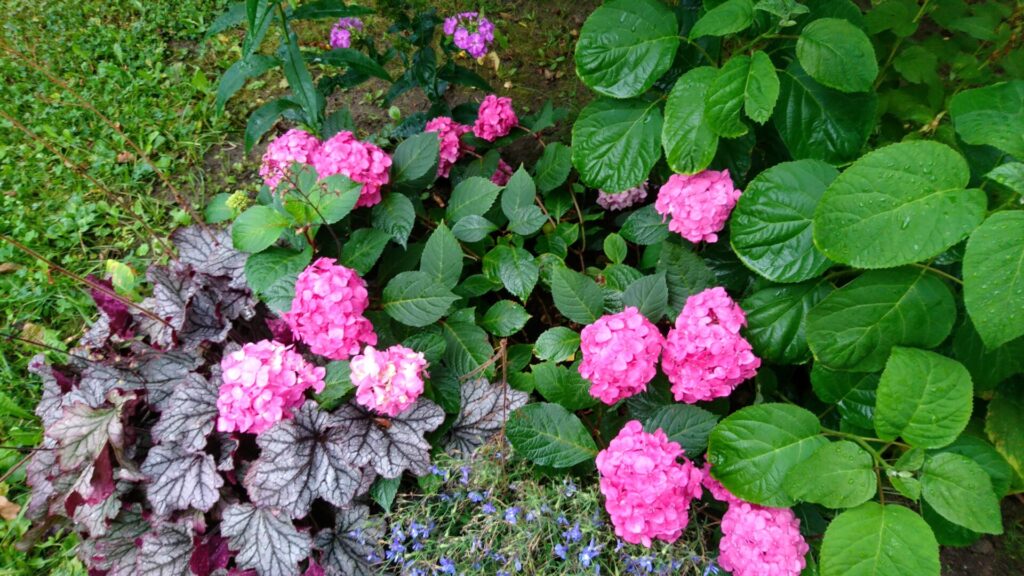
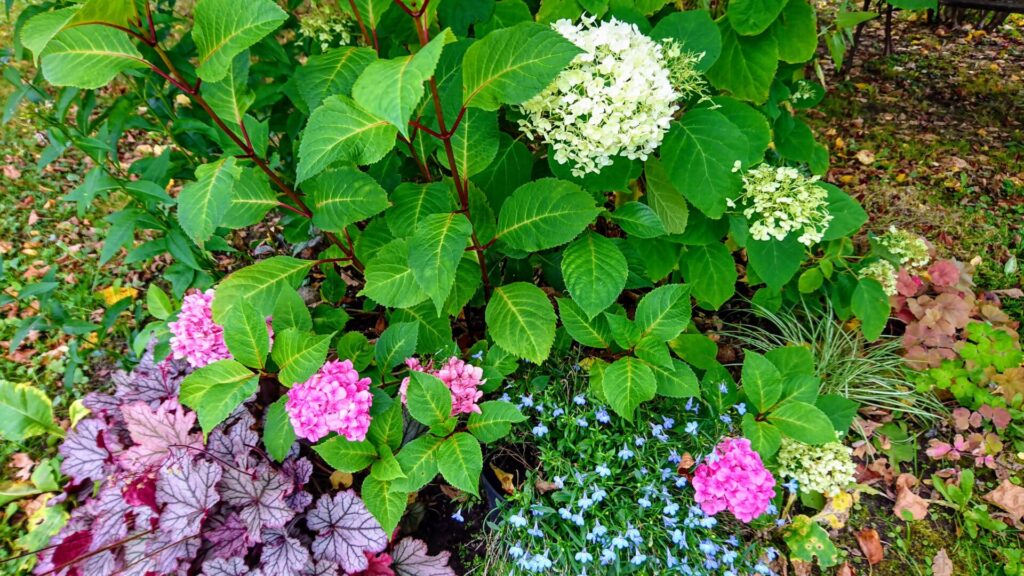
Viimane tulija on aedhortensia Phantom, kes on täielik emotsiooniost, sest käisime vaatamas seda:
The latest arrival is the panicled hydrangea Phantom, which is a complete emotional purchase, because we went to see it:
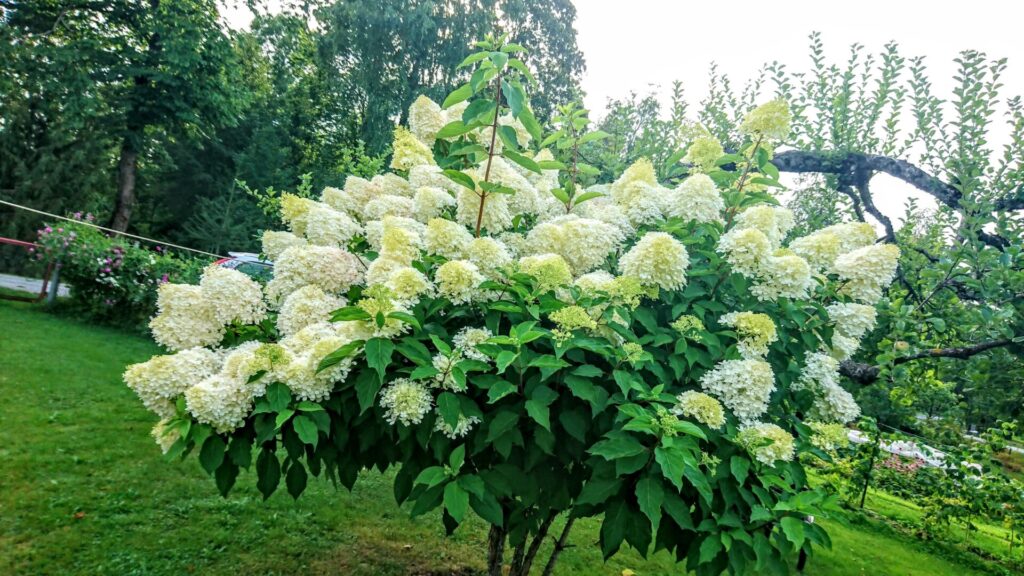
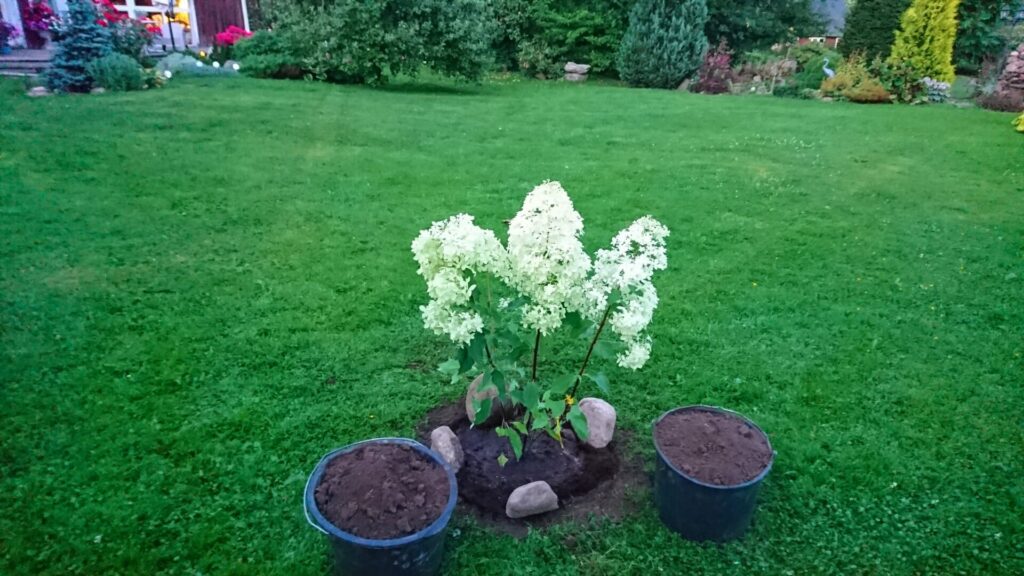
Nüüd pole muud, kui ootama jääda.
Now there is nothing to do but wait.
